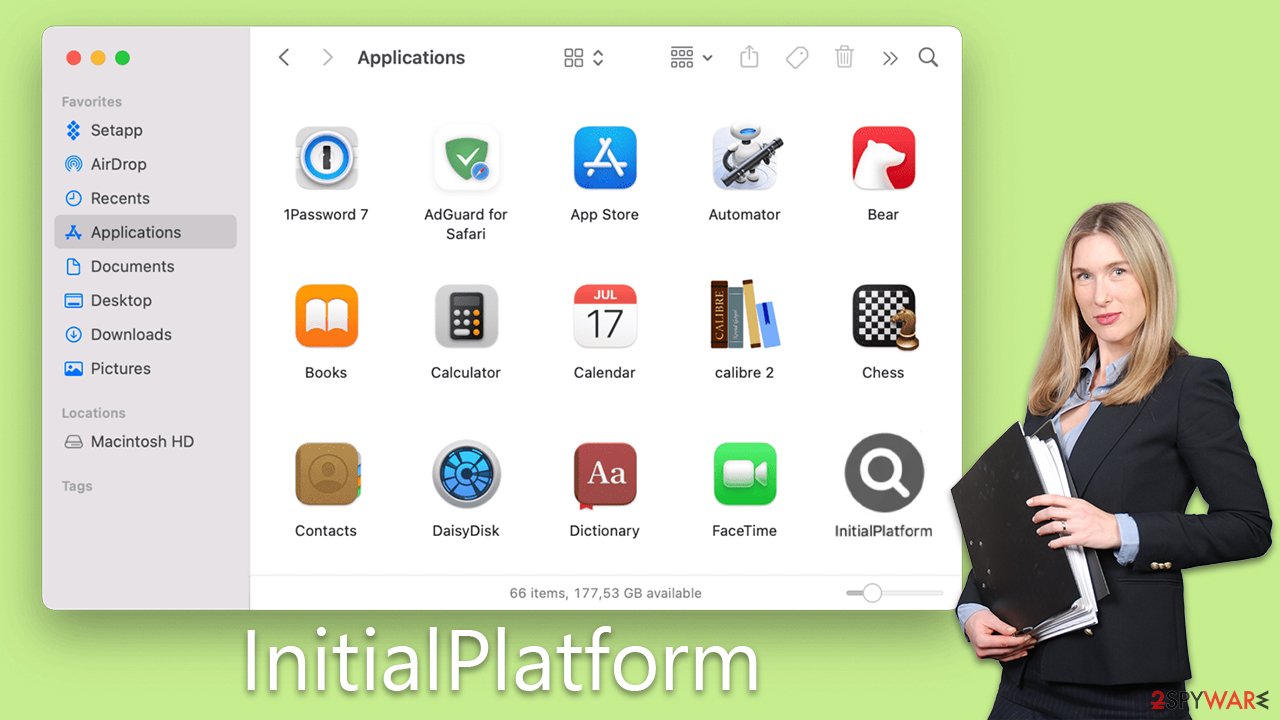InitialPlatform Mac virus (Removal Guide)
InitialPlatform Mac virus Removal Guide
What is InitialPlatform Mac virus?
InitialPlatform is a Mac virus you definitely want to avoid

Every year sees an increase in cyberattacks targeting Mac systems, with adware emerging as a prominent concern for macOS. InitialPlatform, derived from the Adload family, has persistently threatened macOS users over the years, displaying minimal variation between its versions. In a bid to enhance the malware's longevity and dissemination, the perpetrators continually update it, though several of its core features remain consistent.
The primary goal of InitialPlatform is revenue generation through advertising. Once a device is compromised, users are exposed to an array of online threats during their browsing sessions. These threats encompass phishing sites, online frauds, malicious links, and more, primarily because this malware is associated with several unwanted apps and dubious sites. Although not every popup or link is malicious, distinguishing the safe ones becomes an intricate challenge.
| Name | InitialPlatform |
| Type | Mac virus, adware, browser hijacker |
| Malware family | Adload |
| Distribution | Fake Flash Player installers or pirated software from high-risk sources |
| Symptoms | Installs a new extension and application on the system; changes homepage and new tab of the browser; inserts ads and malicious links; tracks sensitive user data via extension |
| Removal | The fastest way to remove Mac malware is to perform a full system scan with SpyHunter 5Combo Cleaner security software. We also provide a manual guide below |
| System optimization | After you terminate the infection with all its associated components, we recommend you also scan your device with FortectIntego to clean your browsers and other leftover files from the virus |
How the infection occurs
InitialPlatform, a malware specifically designed to target Mac users, employs several distribution methods to infect computers. Notably, fake Flash Player updates and software downloads from unauthenticated sources are the primary avenues of its spread.
One prevalent technique employed by the Adload family is the utilization of fake Flash Player updates. To do this, cybercriminals craft deceptive websites that closely resemble legitimate Adobe platforms. These websites prompt users to download a so-called Flash Player update. By clicking the download link, users inadvertently introduce the malware into their systems.
The design intricacies of these counterfeit sites are worth noting. With a careful selection of logos and imagery that mirror the official Adobe platform, they strive to appear authentic. Additionally, they frequently deploy alarmist strategies to urge users into downloading the fictitious update, asserting risks like potential hacking threats or restricted content access if the update isn't installed. Regrettably, these strategies often succeed, leading many to infect their Macs with the virus.
Another significant propagation method for InitialPlatform is through the download of software from unofficial repositories. Cybercriminals generate tampered versions of sought-after software – be it Adobe tools, VPN services, or security applications. While these adulterated software variants are marketed as cost-free alternatives, they clandestinely carry malware.
Opting for these unofficial software versions often stems from users' reluctance to bear the software costs or to follow legitimate purchase processes. Yet, this decision introduces numerous security vulnerabilities. Beyond just InitialPlatform, users might inadvertently download other malware types, including trojans or spyware, by relying on these dubious sources.
Dangers of malware infection
Initiated in 2017, Adload has stood the test of time as a persistent malware strain. Throughout its existence, the undisclosed developers of this malware have released hundreds of its variants, ensnaring thousands of unsuspecting users globally. Moreover, it has been linked to other notable Mac-centric malware, such as the Shlayer Trojan.
The predominant goal of InitialPlatform and its offshoots is to secure consistent revenue from advertisements that stealthily populate the browsers of impacted users. These inserted ads are typically of subpar quality, primarily because the malware's authors rely on untrustworthy ad networks.
Furthermore, InitialPlatform embeds a man-in-the-middle proxy within the compromised system. This tactic permits online traffic to be redirected via the servers operated by these malicious actors. In doing so, not only do they profit from the diverted website traffic, but they also place users at risk by directing them to potentially harmful websites and advertisements.

Owing to the elevated permissions with which the malware operates, its browser extension facet can surreptitiously harvest sensitive user data. Information like credit card credentials or login specifics can be gleaned. Such data breaches place users in precarious positions, exposing them to potential financial ramifications or even identity theft risks.
Removal explained
Mac users are accustomed to straightforward application removal by merely dragging them to the Trash, which leaves no lingering components behind. Nevertheless, eliminating malware, like InitialPlatform, is a much more intricate affair. Designed with the intention of resilience, these malicious programs aim to persist on a user's device for extended periods – a prolonged presence directly translates to increased profits for cybercriminals.
It's imperative to recognize the seriousness of this malware's impact and prioritize its swift removal. Given InitialPlatform's tenacity and its ability to circumvent built-in Mac protection systems, such as XProtect, basic removal techniques might prove inadequate. Hence, we advise users to utilize reliable security software SpyHunter 5Combo Cleaner or Malwarebytes for the eradication process. Ensure the chosen anti-malware tool is updated to the latest version, and then initiate a comprehensive system scan.
For those who prefer a hands-on approach, detailed manual removal steps are provided below. Regardless of the chosen removal strategy, it's also crucial to cleanse the affected browsers, such as Safari, to ensure a complete purge of all associated risks.
Remove the main components
The malware is apt to execute concealed operations in the background to fulfill its malicious intents. To initiate the removal procedure, we recommend you halt any questionable processes and subsequently remove the primary application by moving it to the trash.
- Open Applications folder
- Select Utilities
- Double-click Activity Monitor
- Here, look for suspicious processes and use the Force Quit command to shut them down
- Go back to the Applications folder
- Find the malicious entry and place it in Trash.
![Uninstall from Mac 1 Uninstall from Mac 1]()
Once the malware has breached your system, it could set up new User profiles and Login items to ensure its continued presence. This might explain the difficulty in eliminating the application or its extension.
- Go to Preferences and select Accounts
- Click Login items and delete everything suspicious
- Next, pick System Preferences > Users & Groups
- Find Profiles and remove unwanted profiles from the list.
Lastly, you need to remove Launch Daemons and any residual configuration data left behind by the malware. Continue with the steps below:
- Select Go > Go to Folder.
- Enter /Library/Application Support and click Go or press Enter.
- In the Application Support folder, look for any dubious entries and then delete them.
- Now enter /Library/LaunchAgents and /Library/LaunchDaemons folders the same way and delete all the related .plist files.
![Uninstall from Mac 2 Uninstall from Mac 2]()
Clean your browsers
Once the virus is in place, it integrates a browser extension into Safari or any other active browser. This addition alters the homepage and the new tab settings, leading users to encounter sponsored links or advertisements.
To restore your browser's regular operation and reclaim control, you'll need to remove the extension characterized by the magnifying glass icon. However, the virus's persistent features might hinder this removal. If the attempt proves unsuccessful, proceed to the subsequent section.
Safari
- Click Safari > Preferences…
- In the new window, pick Extensions.
- Select the unwanted extension and select Uninstall.
![Remove extensions from Safari Remove extensions from Safari]()
Google Chrome
- Open Google Chrome, click on the Menu (three vertical dots at the top-right corner) and select More tools > Extensions.
- In the newly opened window, you will see all the installed extensions. Uninstall all the suspicious plugins that might be related to the unwanted program by clicking Remove.
![Remove extensions from Chrome Remove extensions from Chrome]()
Potentially unwanted programs often embed multiple elements within the browser framework. Having eliminated the virus with the guidance from the prior section, the next step involves cleansing your web browsers. Alternatively, the procedures detailed below can be substituted by deploying our FortectIntego maintenance utility.
Safari
- Click Safari > Clear History…
- From the drop-down menu under Clear, pick all history.
- Confirm with Clear History.
![Clear cookies and website data from Safari Clear cookies and website data from Safari]()
Google Chrome
- Click on Menu and pick Settings.
- Under Privacy and security, select Clear browsing data.
- Select Browsing history, Cookies and other site data, as well as Cached images and files.
- Click Clear data.
![Clear cache and web data from Chrome Clear cache and web data from Chrome]()
Should the harmful extension appear grayed out, standard deletion techniques might prove ineffective. Under these circumstances, a browser reset could be necessary, which would eliminate all your extensions, both harmful and benign. However, you can subsequently reinstall any trusted extensions to regain their features.
Safari
- Click Safari > Preferences…
- Go to the Advanced tab.
- Tick the Show Develop menu in the menu bar.
- From the menu bar, click Develop, and then select Empty Caches.
![Reset Safari Reset Safari]()
Google Chrome
- Click on Menu and select Settings.
- In the Settings, scroll down and click Advanced.
- Scroll down and locate Reset and clean up section.
- Now click Restore settings to their original defaults.
- Confirm with Reset settings.
![Reset Chrome 2 Reset Chrome 2]()
How to prevent from getting adware
Choose a proper web browser and improve your safety with a VPN tool
Online spying has got momentum in recent years and people are getting more and more interested in how to protect their privacy online. One of the basic means to add a layer of security – choose the most private and secure web browser. Although web browsers can't grant full privacy protection and security, some of them are much better at sandboxing, HTTPS upgrading, active content blocking, tracking blocking, phishing protection, and similar privacy-oriented features. However, if you want true anonymity, we suggest you employ a powerful Private Internet Access VPN – it can encrypt all the traffic that comes and goes out of your computer, preventing tracking completely.
Lost your files? Use data recovery software
While some files located on any computer are replaceable or useless, others can be extremely valuable. Family photos, work documents, school projects – these are types of files that we don't want to lose. Unfortunately, there are many ways how unexpected data loss can occur: power cuts, Blue Screen of Death errors, hardware failures, crypto-malware attack, or even accidental deletion.
To ensure that all the files remain intact, you should prepare regular data backups. You can choose cloud-based or physical copies you could restore from later in case of a disaster. If your backups were lost as well or you never bothered to prepare any, Data Recovery Pro can be your only hope to retrieve your invaluable files.








